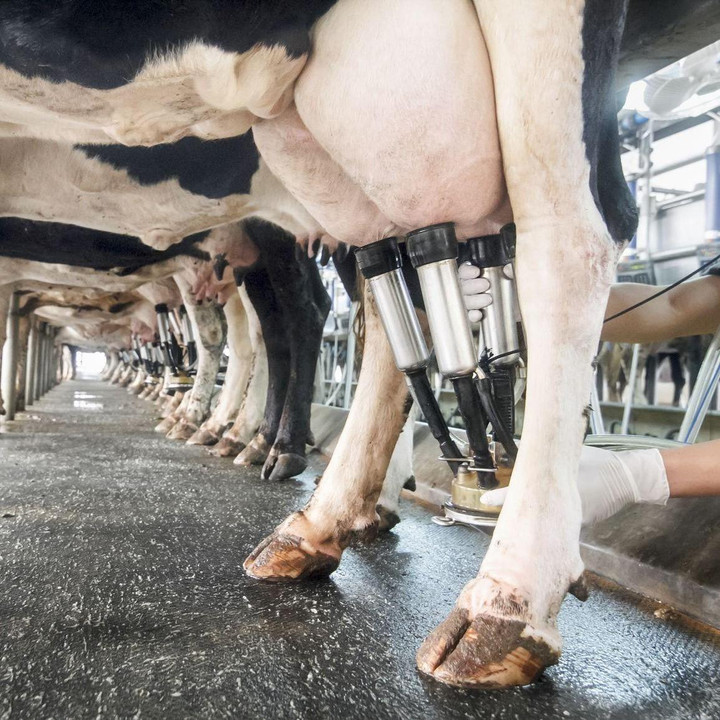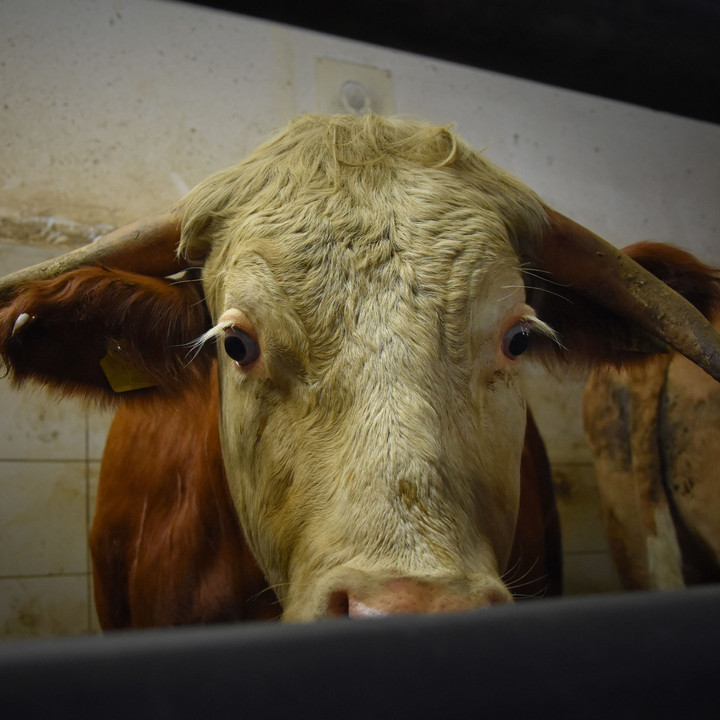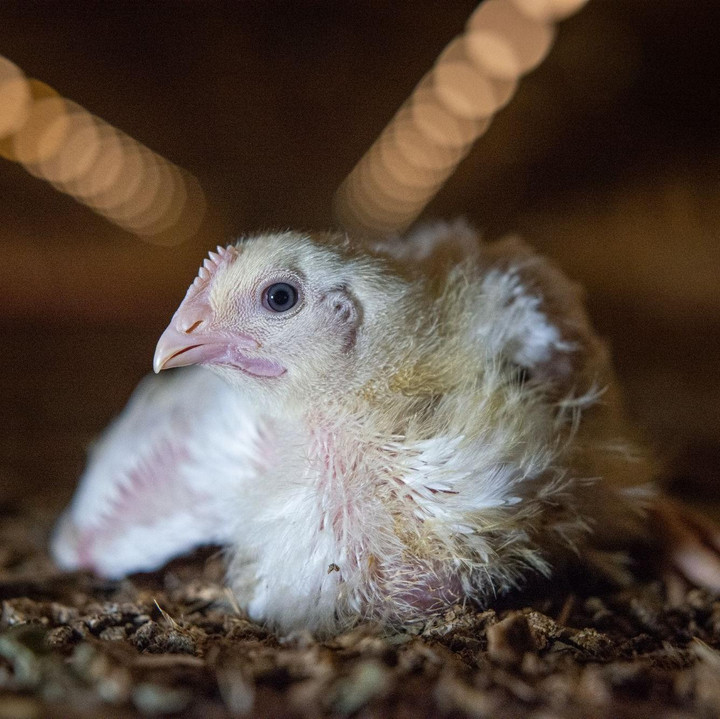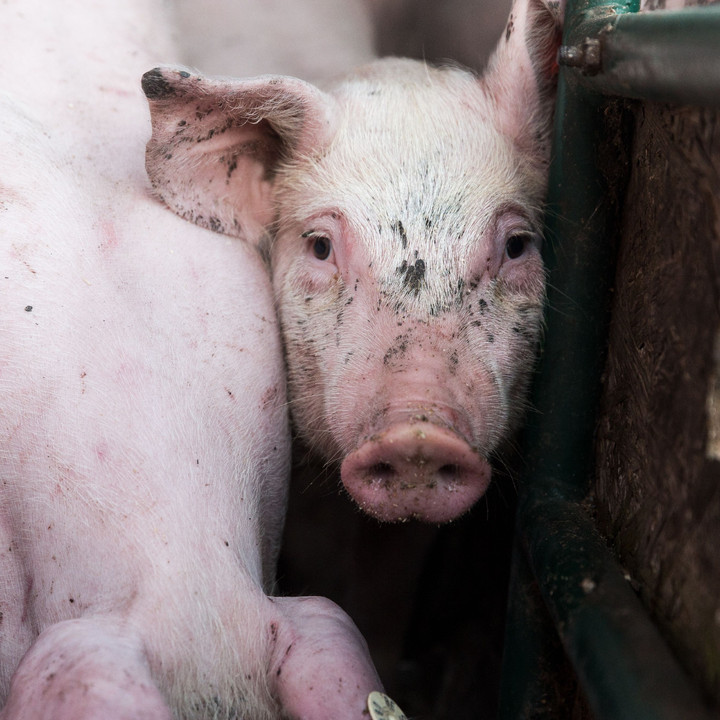
Torture Breeding of Farm Animals
The suffering from traits as a result from highly specialised breeding
The aim of animal breeding is to increase the profitability of animal husbandry by adapting the animals to the husbandry and production conditions. As a result, the increase of performance parameters (e.g., milk yield, laying performance, daily weight gains) is the focus of breeding efforts. This purely performance-oriented breeding causes pain and suffering in the so-called 'farm animals'.
In a single breed, it is not possible to establish several high-yielding traits through breeding (e.g., milk yield, meat yield, or laying yield), therefore breeding has become one-sided. This resulted in different breeds and crosses, namely dairy and beef breeds in cattle or laying and broiler hybrids in chickens.

Dairy cattle
Learn more

Beef cattle
Learn more

Broiler chickens and turkeys
Learn more

Laying hens
Learn more

Pigs
Learn more
Dairy cattle
What our dairy cows have to perform every day: Milk output per cow from an average of 2,600 kg/year of milk in the 1950s has skyrocketed to an average of 7,500 kg/year or more per cow in 20211. And the trend is upward.
What most do not know: Breeding for this enormously high milk yield, which demands everything from physical performance, leads to increased health problems. At the beginning of the milking period, a high-performance cow cannot consume as much feed as she needs for energy, which means that the body's own reserves are used up, making the animals very thin and unhealthy.2

Torture breeding in dairy cattle causes, among other things:
- Udder infections
- Metabolic disorders
- Claw problems
- Lameness
- Fertility problems
- Uterine inflammations

The useful life of our dairy cows has halved in the last 40 years! But this short lifespan and performance-related health disorders, also called production diseases, are accepted for economic interests.
In addition, male calves of dairy breeds are of no value to the industry. They are too expensive to raise and make no economic sense because of their low 'meat yield'. They are sold as quickly as possible, sometimes abroad, where a short and cruel life awaits them. Even the industry speaks of the male calves as a waste product of the dairy industry.3
Beef cattle
The prevailing breeding objectives, such as good muscling and high daily weight gains directly cause health problems in cattle (organ damage, bone and joint problems, combination of health restrictions). Breeds like the Belgian Blue are bred for ‘double muscling’, due to a gene mutation the factor to inhibit muscle growth is switched off. Consequently, natural birthing for these animals is rarely possible and a C-section is almost always necessary.4,5

Torture breeding in beef cattle causes, among other things:
- Metabolic disorders
- Claw problems
- Lameness
- Fertility and birthing problems

Poultry
For decades, the breeding objective has been to maximize genetic growth potential. Extreme selection for high meat amount is associated with increased susceptibility to disease, especially of the skeletal and cardiovascular systems. This results in behavioural changes in locomotion and comfort behaviour, which, since they can no longer be performed in a species-typical manner, lead to further suffering in the animal.6
Laying hens
What our chickens have to perform every day: In 1955, a hen laid about 118 eggs per year. Due to the one-sided breeding for laying performance, the number has meanwhile been increased to about 300 eggs and more per hen per year. The consequences of the genetic change in the sense of maximum performance are that the animals already suffer from osteoporosis at a young age. Further on, the chickens now lay an egg almost every day, which leads to further health problems, such as inflammation of the laying organs.

Torture breeding in laying hens causes, among other things:
- Osteoporosis, sternum damage
- Disease of the laying organs
- Tendency to feather pecking and cannibalism (in intensive farming); consequently, beaks are routinely shortened

Due to the high demand for calcium, which must be mobilized from the hen's own body to form the eggshell, up to 90% of all laying hens in today's common multi-day housing systems suffer sternal lesions and fractures.(7–9)
Additionally due to the high performance of laying hens, inflammation of the fallopian tubes is a commonly occurring problem.10
What many do not know: These high-performance laying hens now do not live much past 16 months – they have no economic use after the first laying period and are 'disposed of' e.g., slaughtered. For the few corporations worldwide, that breed these so-called laying hybrids used today, this is economically advantageous. In addition, male chicks are completely worthless for the egg industry, and due to the one-sided breeding for laying performance, are no longer suitable for economic fattening.10,11
Broiler chickens
In poultry breeding, there is a general problem that the animals used in agriculture are mostly all from the large breeding groups and original 'old' breeds are now only kept and raised by hobby farmers or breed keepers.
The increasingly heavy thoracic muscle and the resulting abnormal leg positions and lameness, mean that the animals hardly move at all towards the end of their lives. Behaviour, appropriate to the species, such as perching on a branch to sleep, is no longer possible as a result. Due to the high weight gain, the animals rest more than normal, which causes damages and inflammations at the breast, the so-called breast buttons and breast blisters.6,12,13

Torture breeding in broilers causes, among other things:
- Painful joint deformities
- Cardiovascular diseases
- Abnormal leg positions and lameness14

Turkeys
The high demand for turkey breast meat, which is known as particularly 'healthy', has devastating consequences for the animals behind the food. Breeding for the enormous size of the breast muscle and the rapid weight gain of the animals within a few weeks of life cause extreme stress on the animal. The juvenile skeleton cannot adequately support the enormous increase in meat, and internal organs cannot keep up with the growth. Nowadays, a turkey has reached the final slaughter weight of about 23 kg at the age of about 20 weeks. In comparison, in 1965, the weight of a turkey at the age of 22 weeks was just about 12 kg.15

Torture breeding in turkeys causes, among other things:
- Painful joint deformities
- Cardiovascular diseases
- Abnormal leg positions and lameness
- Tendency to feather pecking and cannibalism (in intensive farming); consequently, beaks are routinely shortened

The increasingly heavy thoracic muscle and the resulting abnormal leg positions and lameness mean, that the animals hardly move at all towards the end of their lives. Behaviour appropriate to the species, such as perching on a branch to sleep, is no longer possible as a result.(4,16)
Due to the many animals lying in damp bedding, inflammations of the breast and abdomen are common. What many people also do not know: Fattening turkey breeds are no longer able to reproduce naturally. The males would injure the females due to their abnormally large pectoral muscle. These animals are bred by a few corporations worldwide and must be reproduced through artificial insemination. The short life of a turkey is pure suffering.17
Pigs
The demand for lean meat is constantly increasing. For pork production, this means that animals are adapted to meet the demand. Breeding for a high lean meat content, as well as the high daily weight gains, lead to disorders of the cardiovascular system and pathological joint changes in these intelligent creatures.18,19 The juvenile skeleton cannot sufficiently support the enormous increase in meat, and the internal organs cannot keep up with the growth. Nowadays, a fattening pig reaches its slaughter weight of about 110 kg at the age of about six to seven months.20 In pigs a few breeds dominate breeding, such as the Pietrain. The number of piglets per breeding sow per year is an economic parameter which has been continuously increased.21

Torture breeding in pigs causes, among other things:
- Cardiovascular problems
- Pathological joint changes
- Ttail tip and ear rim necrosis
- Piglet suffering and deaths due to too large litters22,23

Meanwhile, sows often already get more piglets than they have teats, which means that the remaining piglets have to be artificially reared at great expense or are killed. On large sow farms, it is common that every morning during the daily animal inspection, weak piglets or piglets weighing less than one kilogram are killed. This killing is often not even done professionally.
Due to the great strain that is placed on the breeding sows, the average age is barley three years. The constantly increasing performance requirements put a strain on animal health.
FOUR PAWS demands:
- Torture breeding of farm animals must be prohibited, and the prohibition must be consequently implemented and enforced.
- In addition to breeding and reproduction, the keeping of animals that fall under the concept of torture breeding must also be prohibited.
- Part of the breeding objective must be to consider characteristics such as animal health and longevity.
- Sows should only give birth to as many piglets as they can care by themself (number of available and functional teats).
- Use of dual-purpose breeds in poultry and cattle farming, as well as old breeds adapted to local conditions.
- Breeds must be bred back in terms of their major welfare problems and high-performance breeds must no longer be used.
Source
2. Walsh SW, Williams EJ, Evans ACO. A review of the causes of poor fertility in high milk producing dairy cows. Animal Reproduction Science. 2011;123(3–4):127–138. doi:10.1016/j.anireprosci.2010.12.001
3. Haskell MJ. What to do with surplus dairy calves? Welfare, economic, and ethical considerations. Landbauforschung : journal of sustainable and organic agricultural systems. 2020;(70(2020)1):45–48. doi:10.3220/LBF1593617173000
4. Demmler D. Leistungsabhängige Gesundheitsstörungen bei Nutztieren für die Fleischerzeugung (Schweine, Rinder, Hühner, Puten) und ihre Relevanz für § 11b Tierschutzgesetz (“Qualzucht”). Berlin: Mensch und Buch Verl; 2011.
5. Kolkman I, Opsomer G, Aerts S, Hoflack G, Laevens H, Lips D. Analysis of body measurements of newborn purebred Belgian Blue calves. Animal. 2010;4(5):661–671. doi:10.1017/S1751731109991558
6. Knowles TG, Kestin SC, Haslam SM, Brown SN, Green LE, Butterworth A, Pope SJ, Pfeiffer D, Nicol CJ. Leg Disorders in Broiler Chickens: Prevalence, Risk Factors and Prevention Callaerts P, editor. PLoS ONE. 2008;3(2):e1545. doi:10.1371/journal.pone.0001545
7. Toscano M. Skeletal problems in contemporary commercial laying hens. In: Advances in Poultry Welfare. Elsevier; 2018. p. 151–173. https://linkinghub.elsevier.com/retrieve/pii/B9780081009154000087. doi:10.1016/B978-0-08-100915-4.00008-7
8. Thøfner ICN, Dahl J, Christensen JP. Keel bone fractures in Danish laying hens: Prevalence and risk factors. PLOS ONE. 2021;16(8):e0256105. doi:10.1371/journal.pone.0256105
9. Stratmann A, Fröhlich EKF, Gebhardt-Henrich SG, Harlander-Matauschek A, Würbel H, Toscano MJ. Genetic selection to increase bone strength affects prevalence of keel bone damage and egg parameters in commercially housed laying hens. Poultry Science. 2016;95(5):975–984. doi:10.3382/ps/pew026
10. Keppler C, Knierim U. Basiswissen Mtool© -eine Managementhilfe für Legehennenaufzucht und -haltung. Universität Kassel; 2017.
11. Eltahan HM, Cho S, Rana MM, Saleh AA, Elkomy AE, Wadaan MAM, Alagawany M, Kim IH, Eltahan HM. Dietary exogenous phytase improve egg quality, reproductive hormones, and prolongs the lifetime of the aging Hy-line brown laying hens fed non-phytate Phosphorus. Poultry Science. 2023 Jun:102895. doi:10.1016/j.psj.2023.102895
12. Hartcher KM, Lum HK. Genetic selection of broilers and welfare consequences: a review. World’s Poultry Science Journal. 2020;76(1):154–167. doi:10.1080/00439339.2019.1680025
13. De Jong IC, Guéméné D. Major welfare issues in broiler breeders. World’s Poultry Science Journal. 2011;67(1):73–82. doi:10/fcsw3s
14. EFSA Panel on Animal Health and Welfare. Scientific Opinion on the influence of genetic parameters on the welfare and the resistance to stress of commercial broilers. EFSA Journal. 2010;8(7):1666. doi:10.2903/j.efsa.2010.1666
15. van Staaveren N, Leishman EM, Wood BJ, Harlander-Matauschek A, Baes CF. Farmers’ Perceptions About Health and Welfare Issues in Turkey Production. Frontiers in Veterinary Science. 2020 [accessed 2020 Jun 24];7. https://www.frontiersin.org/articles/10.3389/fvets.2020.00332/full. doi:10/gg6p9n
16. Glatz P, Rodda B. Turkey farming: Welfare and husbandry issues
17. Erasmus MA. 13 - Welfare issues in turkey production. In: Mench JA, editor. Advances in Poultry Welfare. Woodhead Publishing; 2018. p. 263–291. (Woodhead Publishing Series in Food Science, Technology and Nutrition). https://www.sciencedirect.com/science/article/pii/B9780081009154000130. doi:10.1016/B978-0-08-100915-4.00013-0
18. EFSA Panel on Animal Health and Welfare (AHAW), Nielsen SS, Alvarez J, Bicout DJ, Calistri P, Canali E, Drewe JA, Garin-Bastuji B, Gonzales Rojas JL, Schmidt G, et al. Welfare of pigs on farm. EFSA Journal. 2022;20(8):e07421. doi:10.2903/j.efsa.2022.7421
19. Busch ME, Wachmann H. Osteochondrosis of the elbow joint in finishing pigs from three herds: Associations among different types of joint changes and between osteochondrosis and growth rate. The Veterinary Journal. 2011;188(2):197–203. doi:10.1016/j.tvjl.2010.03.021
20. Production Cycle of Swine.
21. Ward SA, Kirkwood RN, Plush KJ. Are Larger Litters a Concern for Piglet Survival or An Effectively Manageable Trait? Animals : an Open Access Journal from MDPI. 2020;10(2):309. doi:10.3390/ani10020309
22. van Essen GJ, te Lintel Hekkert M, Sorop O, Heinonen I, van der Velden J, Merkus D, Duncker DJ. Cardiovascular Function of Modern Pigs Does not Comply with Allometric Scaling Laws. Scientific Reports. 2018;8:792. doi:10.1038/s41598-017-18775-z
23. Reiner G, Kuehling J, Loewenstein F, Lechner M, Becker S. Swine Inflammation and Necrosis Syndrome (SINS). Animals. 2021;11(6):1670. doi:10.3390/ani11061670


